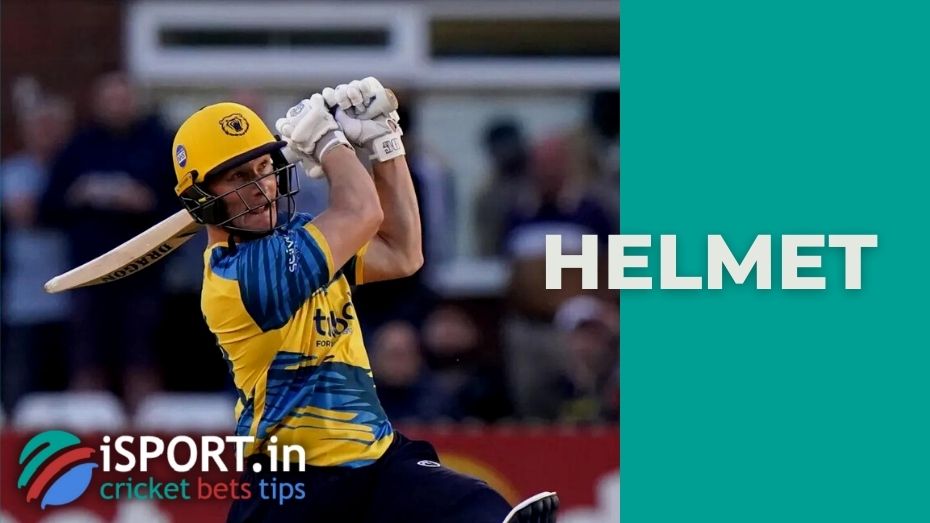Helmet

Helmet in cricket is an essential piece of equipment. It began to be widely used in the second half of the twentieth century.
Helmet in Cricket: History
Although cricket is not the most physically demanding sport, there are some positions in which extra protection is absolutely necessary, such as the wicket-keeper one. In the 1930s of the previous century, for instance, Patsy Hendren took the field wearing a handmade hat that was supposed to protect his head. It is common knowledge that players attempted to manufacture the essential equipment items on their own. However, prototypes of the first helmet in cricket did not appear until decades later.
Dennis Amiss, who was one of the first cricket players to make them trendy, appeared on the field wearing a motorbike helmet that had been custom-made for him before he pitched. Later on, he was joined by Mike Brearley, who was responsible for the design of his protective cover, and then Graham Yallop, who was the first person in the history of test cricket to attend a match while wearing a helmet (in March 1978).
Even though some cricketers (for example, Tony Craig) considered helmets not only unnecessary but also outright dangerous, explaining this by the fact that bowlers would no longer rely on force on impact, they quickly became fashionable. When Viv Richards retired in 1991, he was the final batter to take a stand against wearing a helmet in cricket during test matches on the basis of principle.
The International Cricket Council (ICC) is now the standard by which a helmet in cricket is made. It is interesting to note that the organization did not make the wearing of helmets a hard requirement in 2017, instead delegating the discretion to each nation that has test status (the only exception being players who are under the age of 18).
For instance, the England and Wales Cricket Board has mandated that all batters, wicket keepers, and fielders who are fewer than eight yards away from the wicket are required to wear helmets. While this is going on, batters in India and New Zealand are not required to do so if they believe they are capable of performing without the need for extra protection.
Helmet in Cricket: Materials
A batter who desires to protect himself is only permitted to enter the field wearing a helmet in cricket that satisfies the British standard BS7928: 2013, as stated by the regulations that are currently in place by the International Cricket Council (ICC). Ultra-modern shock-resistant materials, such as ABS plastic, titanium, steel, high-density foam, and other similar materials, are used in the construction of helmets.
There are six standard helmet sizes:
- Size Girth, cm
- Small Junior 51-54
- Junior 53-54
- Youths 54-56
- Small Senior 56-58
- Senior 58-60
- Large Senior 60-62
Modern cricket helmets are made from the following materials:
- Outer shell – ASB-plastic, fiberglass, carbon fiber. A particular type of lightweight thermoplastic that is simple to make is known as ASB plastic. ASB plastic is not the most durable of the materials that are now available. Its wear resistance is poor in comparison to that of fiberglass. Nonetheless, it is more affordable and offers excellent protection against impact. Due to the fact that it is heavier than ASB, fiberglass is less popular than ASB; hence, the majority of professional cricketers choose the third choice, which is carbon fiber. Furthermore, it is dependable and long-lasting, which is of utmost significance for athletes who are participating in test matches.
- Padding – high-density foam. High-density foam not only provides a high level of stress absorption but also allows the flexibility of the components. The vast majority of the time, cricket players have the choice of selecting either a base material that has a dense collection of tiny bubbles or one that contains bigger bubbles. The second kind of cushioning contributes to the helmet’s springiness, but it also makes it less resistant to impacts.
- Lattice – steel or titanium. In addition to being the first choice more conventional, but it also has a lower financial impact. On the other hand, the majority of players choose titanium since it is a lightweight and pleasant material that reduces the amount of pressure that the helmet exerts on the neck.
- Chin strap – nylon. It is the material that is used the most often for this helmet in cricket components since it is long-lasting and has the capacity to sustain continuous stress. In addition to this, it does not cause irritation to the skin, which is particularly crucial while playing matches for a protracted period of time in circumstances of high humidity and heat.
Interesting: The most popular brands of cricket helmets are Gunn & Moore, Sanspareils Greenlands and Sareen Sports Industries.
